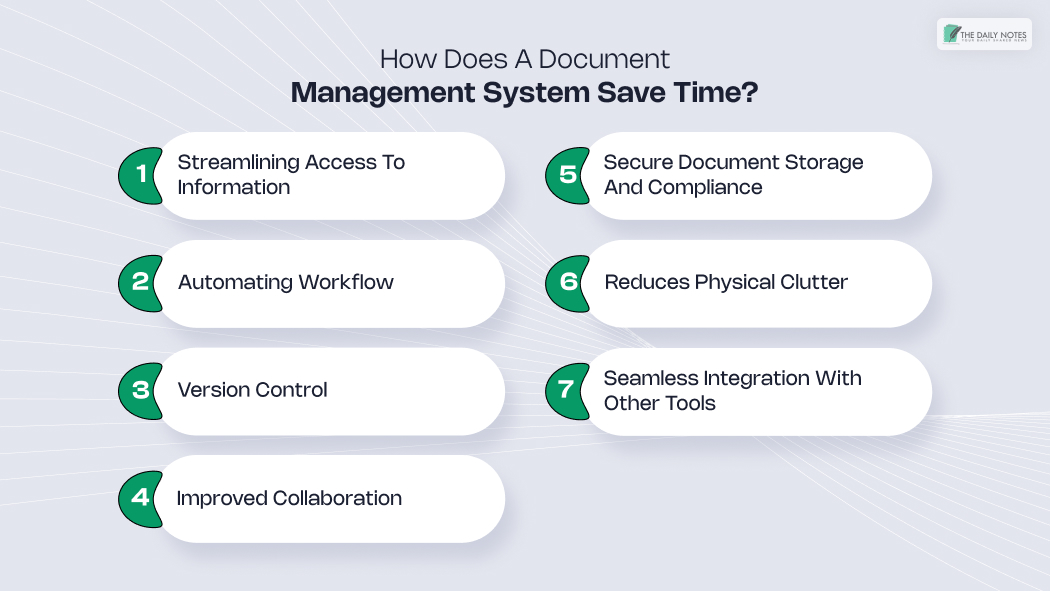Today’s fast-paced work environment demands productivity and efficiency like before. Yet disorganization in files and misplacement of documents bogs down many professionals and companies. Leading to time lost in searching for critical information. A document management system can take care of all of this, easily.
Imagine gaining an additional 7 hours per week simply by implementing this system to optimize how you store access and manage your document. Now that counts as an ideal work environment!
With this system, you can drastically cut down on the time spent on manual tasks and administrative bottlenecks.
The following sections will explore how digital document management solutions can streamline workflow. From reducing clatter, and increasing productivity by saving valuable hours each day.
What is a Document Management System?

A document management system is a software solution allowing organizations to centrally create, store, organize, and retrieve digital documents. It acts as a digital filing cabinet securely storing all files, records, and essential information.
Unlike traditional paper filing systems, a document management system allows advanced features. It includes version control, automated workflows, metadata tagging, and secure access.
This system is more than just a place to store documents. It is a comprehensive tool that helps manage the entire document life cycle management process.
That is, from the document’s creation to its storage and archiving to disposal.
How Does a Document Management System Save Time?

Incorporating a digital document management system into your workflow eliminates many inefficiencies associated with manual document handling. Think of it as part of your productivity hacks where you don’t spend a gazillion hours searching for documents!
Here are some ways a document operating system solution can save you valuable 7 hours weekly. Let’s have a look:
Streamlining Access to Information
One of the most time-consuming activities in any office is searching for documents. Whether you’re rifling through paper files or scanning emails to find that one attachment, time quickly slips away while searching.
Thanks to robust search functionalities, a document management system solves this problem by making finding the information you need incredibly easy.
You can search using keywords, tags, dates, or any other matter data attached to the document, retrieving what you need in seconds instead of minutes or even hours.
Automating Workflow
Many companies deal with manual processes that become repetitive. One of those is document approval distribution and filing. With document management solutions, you can automate many workflows and save time, reducing human error.
For instance, when a new contract needs approval, the system can automatically be routed to the appropriate individuals to track progress and send reminders, all without manual intervention.
Automated workflow means fewer bottlenecks and a faster turnaround time for essential tasks – that’s financial wellness 101 if you ask me.
Version Control
Managing different versions of the same document can be a nightmare, especially in a large setting such as an organization. Without version control, employees can accidentally work on updated files and overwrite someone else’s work.
A digital document management system ensures that everyone is working on the latest version of a document, preventing time wastage, rework, and miscommunication.
Version control also provides a history of changes made, allowing team members to track revisions and roll back to earlier versions if needed.
Improved Collaboration
Collaboration gets hindered when team members have difficulty accessing the same documents. Or even ensuring that employees are working on the most current version.
Document management systems enhance collaboration by providing real-time shared access to documents. This allows employees to view, edit, and comment on documents simultaneously from different locations.
This eliminates the need for back-and-forth emails and long waves for file sharing, significantly speeding up the workflow and improving team productivity.
Secure Document Storage and Compliance
Several industries, such as finance, healthcare, and legal, require strict adherence to regulatory compliance regarding document management. Failure to comply led to hefty fines and reputational damage.
A document management system provides secure encrypted storage with audit trails and permission-based access. This ensures that only authorized personnel view or edit sensitive documents.
It also reduces the time spent on compliance audits and ensures that the records are safely stored following industry regulations.
Reduces Physical Clutter
Physical filing systems and paper documents can take up valuable space and time to sort, store, and retrieve. By digitizing documents and managing them through a document management system, you can eliminate the need for bulky filing cabinets and paperwork files.
This creates a cleaner, more organized workspace, which can help employees focus better and improve their overall productivity.
Seamless Integration with Other Tools
Modern document management systems are integrated seamlessly with other business tools like customer relationship management, project management platforms, and enterprise resource planning software.
This integration allows the automatic flow of information between systems, reducing the time spent manually transferring data from one platform to another.
For example, contracts stored in the system can be automatically linked to client profiles in the CRM, streamlining the process and reducing the risk of human error.
Importance of Document Lifecycle Management

One of the critical features of an efficient document management system is the stability of managing the entire document life cycle. This involves tracking the document from its creation and active use to its eventual archival or destruction.
Effective document life cycle management ensures the documents are only kept if needed and disposed of properly when no longer relevant.
Managing the life cycle of documents is especially important in industries that deal with large volumes of records, such as legal healthcare and government sectors. Automating the process allows businesses to save time on manual tracking, ensuring that outdated documents are securely removed.
Thus, avoiding compliance risk and reducing storage costs.
How to Increase Day-to-day Productivity with Document Management

No, that is covered in how a document management system streamlines workflow and saves time. Let’s look at the broader impact on productivity.
When employees no longer worry about miscellaneous documents or manual filing, they can focus on higher-value tasks like strategy problem-solving and client interactions. This internship leads to increased job satisfaction and higher efficiency.
By freeing time from document management, ask employees to dedicate more energy to innovate and collaborate, ultimately improving the quality of work. In addition, with the added security features of this system, companies can reduce the risk of data breaches, ensuring that time is not wasted on recovering lost or compromised information.
How to Choose the Right Document Management System

Reaping the benefits of a document management system requires selecting the right solution that fits the business needs. Factors to consider include:
- Scalability
- Ease of use integration capabilities
- The level of customer support provided by the vendor
A document management system that is too complex may hinder adoption, while one that lacks scalability may restrict business growth in the long term.
Businesses should also consider the industry requirements for security and compliance, ensuring that the chosen solution adequately protects sensitive data. The best digital document operating systems offer customization options so businesses can tailor them to their unique workflow needs.
Wrapping It Up!
Implementation of a document management system can drastically change the way businesses operate. It is possible to free up valuable hours once spent on manual, time-consuming tasks.
This system offers streamlined workflows, automated processes, and secure insurance storage, amongst other productivity benefits.
Whether your small business or a large corporation, the time saved through efficient document life cycle management and digital document handling can be helpful in the competitive market.
If you are looking to improve your productivity, reduce clutter, and gain an extra 7 hours per week, it’s time to consider the document management system that meets your needs.
Read More:




























